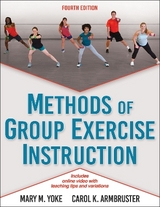
Methods of Group Exercise Instruction
Human Kinetics (Verlag)
978-1-4504-2189-8 (ISBN)
- Titel erscheint in neuer Auflage
- Artikel merken
Formats, modalities, and trends in group exercise are constantly evolving. Methods of Group Exercise Instruction, Third Edition With Online Video, explores the most common group exercise modalities, enhancing readers’ marketability by giving them the skills to lead dynamic, safe, and effective classes. This text highlights the commonalities of a variety of group exercise formats through training principles, correction and progression techniques, and safety tips to enhance the skills of both group exercise leaders and program directors.
Methods of Group Exercise Instruction, Third Edition, moves from theory to practice in a logical progression. Rather than simply providing routines, this book helps instructors develop the core skills needed for creating routines, use proper cueing, and adapt their teaching to new modalities. Teaching techniques convey appropriate training for each muscle group and methods for warm-up, cardiorespiratory training, muscular conditioning, neuromotor training, and flexibility. In addition, starter routines, modification strategies, and instructor assessment criteria are presented for seven class formats: kickboxing, step training, stationary indoor cycling, sport conditioning and boot camp, water exercise, yoga, and mat-based Pilates. The text also touches on alternative modalities, including dance-based classes, fusion, and mind–body training.
Thoroughly revised and reorganized based on industry standards, the third edition of Methods of Group Exercise Instruction offers expanded content to help readers become better instructors. Updates to the third edition include the following:
• Online video, totaling over 100 minutes, demonstrates key content in the text.
• New chapters cover social aspects of group exercise, coaching-based instructional models, and neuromotor and functional training.
• Callout boxes highlight important topics, research findings, technique and safety checks, and practice drills, which facilitate quick learning.
• Short assignments at the close of each chapter encourage readers to look beyond the text to gain practical experience.
• Evaluation forms and evaluation key points allow instructors to gauge their teaching success and adapt the key criteria of a successful class to each exercise modality.
The three-part structure of this book is retained from the previous edition, but the content is reorganized to better reflect industry standards and guidelines. Part I provides a general overview of group exercise: the evolution and advantages of group exercise; the strategies for creating group cohesion in a class; the core concepts in class design; and the use of music, choreography, and cueing methods in designing and leading a class. Part II offers guidelines for leading the four major segments of a group exercise class: warm-up, cardiorespiratory training, muscular conditioning, and flexibility training, and includes a new chapter on neuromotor and functional training. These basic concepts pertain to all modalities covered in part III, which focuses on practical teaching skills. Basic moves, choreography, and training systems are covered for each type of class. Sample routines and class formats for each modality offer a confident starting point for novice instructors and fresh material for veterans. The final chapter discusses customized or hybrid classes such as lifestyle physical activity–based classes, equipment-based cardio classes, and mind and body classes.
When used as a course text, Methods of Group Exercise Instruction, Third Edition, includes instructor ancillaries, which offer suggestions for effective use of the book and online video, lesson plan outlines, a sample week-by-week syllabus, lab activities, and test questions. The third edition also features a newly added image bank containing all the figures and photos from the text to use in presentations.
Carol Kennedy-Armbruster, PhD, is a senior lecturer in the school of public health in the department of kinesiology at Indiana University at Bloomington. During her more than 30 years of teaching and training fitness leaders, she has served on the American Council on Exercise (ACE) and the American College of Sports Medicine (ACSM) credentialing committees, and she chaired the IDEA Water Fitness Committee. Her research interests are translational research for physical activity and functional movement experiences for an over-40 population. Certified through ACE as a group fitness instructor, ACSM as a health fitness instructor, and FMS as a functional movement specialist, Kennedy-Armbruster is a regular presenter at fitness conferences. At Indiana University, she managed the recreational sport fitness and wellness program that included more than 100 group exercise sessions per week before moving to the department of kinesiology to assist with the creation of the health fitness specialist undergraduate major. Kennedy-Armbruster earned her bachelor’s degree in leisure studies from the University of Illinois and her master’s degree in exercise and sport science from Colorado State University. She completed her PhD in human performance at Indiana University while working with a military over-40 population. She has created and taught methods of group leadership classes at three major universities and continues to engage in and lead group movement experiences. Kennedy-Armbruster and her family reside in Greenwood, Indiana. She enjoys outdoor activities, biking, tennis, reading, traveling, and spending time with her family and friends. Mary M. Yoke, MA, MM, has more than 30 years of experience teaching and training group exercise leaders. In addition to leading group exercise classes on a regular basis, she is a lecturer in the school of public health in the department of kinesiology at Indiana University at Bloomington, where she teaches several undergraduate courses in exercise leadership. She is an adjunct board member and master trainer for the Aerobics and Fitness Association of America (AFAA) and served on the American College of Sports Medicine (ACSM) credentialing committee for six years. Yoke has led seminars for fitness professionals in Europe, Asia, Africa, and South America. She gives numerous presentations throughout the United States to both fitness professionals and the general public. She is the author of two other books on fitness as well as three videos. Holding 19 certifications from organizations such as the ACSM, AFAA, American Council on Exercise (ACE), National Academy of Sports Medicine (NASM), and Stott Pilates, Yoke received her master’s degree in exercise physiology from Adelphi University, where she has coauthored several research studies on group exercise.
Part I: Fundamentals of Group Exercise Instruction
Chapter 1. Best Practices
Evolution of Group Exercise
Role of Group Exercise
Trends in Group Exercise
Business Basics for Group Exercise
Chapter Wrap-Up
Assignment
Chapter 2. Social Aspects of Group Exercise
Creating Group Cohesion
Instructors as Role Models
Creating a Healthy Emotional Environment
Student-Centered Versus Teacher-Centered Instruction
Chapter Wrap-Up
Assignments
Chapter 3. Foundational Components
Integrating Components of Health Into Class Design
Creating a Positive Preclass Environment
Principles of Muscular Balance
Balancing Strength and Flexibility
Range of Motion for Major Joints
Progressive Functional Training Continuum
The Group Exercise Class Evaluation Form
Chapter Wrap-Up
Assignment
Chapter 4. Traditional Concepts
Applying Music Skills in Group Exercise
Traditional Choreography
Basic Moves
Elements of Variation
Creating Smooth Transitions
Building Basic Combinations
Additional Choreography Techniques
Cueing Methods in Group Exercise
Chapter Wrap-Up
Assignments
Chapter 5. Coaching-Based Concepts
Motivational Strategies for Coaching-Based Group Exercise
Creating Dynamic Team Environments
Exercise Modification for Injury Prevention
Demonstrating Proper Alignment and Giving a Variety of Cues
Programming Music in a Class That Is Not Beat Driven
Chapter Wrap-Up
Assignments
Part II: Primary Components of Group Exercise
Chapter 6. Warm-Up and Cool-Down
Designing a Warm-Up
Evaluating Stretching in the Warm-Up
Designing a Cool-Down
Chapter Wrap-Up
Assignments
Chapter 7. Cardiorespiratory Training
Cardiorespiratory Training Systems
Beginning Intensity
Appropriate Intensity Levels
Intensity Monitoring
Principles of Muscular Balance in Cardiorespiratory Training
Safety Issues, Good Alignment, and Technique
Importance of Participant Interaction and Enjoyment
Cool-Down After the Cardio Segment
Chapter Wrap-Up
Assignment
Chapter 8. Muscular Conditioning and Flexibility Training
Recommendations and Guidelines for Muscular Conditioning
Cueing Muscular Conditioning Exercises
Demonstrating Progressions, Regressions, Modifications, and Alternatives
Safety Issues in Muscular Conditioning
Equipment for Muscular Conditioning
Recommendations and Guidelines for Flexibility Training
Cueing Flexibility Exercises and Ending a Class Appropriately
Safety Issues in Flexibility Training
Muscular Conditioning and Flexibility Exercises
Chapter Wrap-Up
Assignments
Chapter 9. Neuromotor and Functional Training
Neuromotor Training Principles and Recommendations
Functional Training Principles
Safety Issues in Balance and Functional Training
Equipment for Balance and Functional Training
Teaching a Balance Class
Teaching a Functional Training Class
Chapter Wrap-Up
Assignments
Part III: Group Exercise Modalities
Chapter 10. Kickboxing
Creating a Warm-Up
Technique and Safety Issues
Basic Moves
Combinations and Choreography Techniques
Other Kickboxing Formats
Chapter Wrap-Up
Group Exercise Class Evaluation Form: Key Points
Assignment
Chapter 11. Step Training
Creating a Warm-Up
Technique and Safety Issues
Basic Moves and Step Patterns
Basic Combinations and Choreography Techniques
Training Systems
Chapter Wrap-Up
Group Exercise Class Evaluation Form: Key Points
Assignment
Chapter 12. Stationary Indoor Cycling
Positioning, Alignment, and Safety
Creating a Warm-Up
Basic Moves
Formatting Indoor Cycling Classes
Intensity Monitoring
Cueing and Coaching Techniques
Chapter Wrap-Up
Group Exercise Class Evaluation Form: Key Points
Assignments
Chapter 13. Sport Conditioning and Boot Camp
Creating a Warm-Up
Equipment and Setup
Planning Safe, Effective Movements
Basic Moves
Chapter Wrap-Up
Group Exercise Class Evaluation Form: Key Points
Assignments
Chapter 14. Water Exercise
Benefits of Water Exercise
Properties of Water and Newton’s Laws of Motion
Creating a Warm-Up
Formatting Water Exercise Classes
Training Systems
Water Exercise Equipment
Basic Moves
Chapter Wrap-Up
Group Exercise Class Evaluation Form: Key Points
Assignment
Chapter 15. Yoga
Philosophy of Yoga
Breathwork in Yoga
Beginning a Yoga Class
Verbal Cues and Music
Technique and Safety Issues
Equipment and Class Setting
Basic Asanas (Postures)
Chapter Wrap-Up
Group Exercise Class Evaluation Form: Key Points
Assignments
Chapter 16. Pilates
The Pilates Method: Basic principles
Creating a Warm-Up
Verbal Cues and Music
Technique and Safety Issues
Ending a Pilates Class
Basic Moves
Chapter Wrap-Up
Group Exercise Class Evaluation Form: Key Points
Assignments
Chapter 17. Alternative Modalities in Group Exercise
Creating a Client-Centered Group Exercise Class
Group Exercise for Niche Markets
Lifestyle-Based Physical Activity Classes
Dance-Based Classes
Equipment-Based Cardiorespiratory and Strength Training
Mind–Body Classes
Fusion Classes
Ethical Practice Guidelines for Group Fitness Instructors
Chapter Wrap-Up
Group Exercise Class Evaluation Form: Key Points
Assignment
| Verlagsort | Champaign, IL |
|---|---|
| Sprache | englisch |
| Maße | 216 x 279 mm |
| Gewicht | 1406 g |
| Themenwelt | Sachbuch/Ratgeber ► Gesundheit / Leben / Psychologie |
| Sachbuch/Ratgeber ► Sport | |
| ISBN-10 | 1-4504-2189-X / 145042189X |
| ISBN-13 | 978-1-4504-2189-8 / 9781450421898 |
| Zustand | Neuware |
| Haben Sie eine Frage zum Produkt? |
aus dem Bereich



